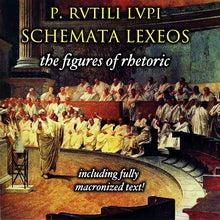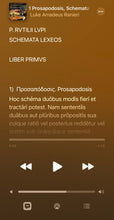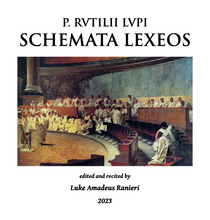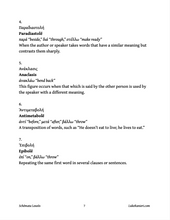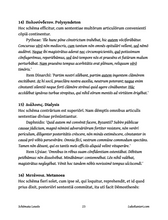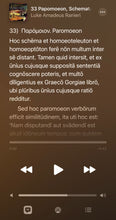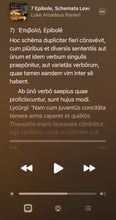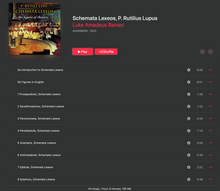
Schēmata Lexeōs, the Figures of Speech by Publius Rutilius Lupus teaches some of the most important rhetorical devices used by ancient authors in both prose and poetry. This audiobook download includes:
• Audio files in Latin of the entire unabridged work
• Macronized text: PDF with all the long vowels clearly marked
• Lyrics feature in Music player reveals the text while you listen on your mobile device
• English explanations of the rhetorical figures
My Sēnātōrēs tier patrons on Patreon get this entire audiobook for free! So consider signing up to be a patron at patreon.com/LukeRanieri.
HOW DO USE THIS AUDIOBOOK & SUPPORTING MATERIALS
Once you receive the link for digital download, DOWNLOAD THE FILE ON A COMPUTER, not a mobile device, unless you are particularly savvy with mobile devices (this is generally not recommended, however). Unzip the compressed file. In it are the PDFs and audio files. You will have to manually transfer the audio files to the music or audiobooks application/program of your choice, and syncronize the audio files to mobile devices, etc., in the way that makes sense for your digital ecosystem; for example, on a Mac, place the files in the Music application, and sync it with the Music application on your iPhone.
You will likely wish to synchronize the audio files with your mobile device. To further aid you in this respect, I have attached the dialogue's text to the audio files themselves as lyrics metadata, so most will be able to visualize the text via the Lyrics feature (as it is called in the iOS Music app) while listening. (If for some reason your audio player does not show the lyrics, you can investigate ways to copy and paste the text from the PDF into each track in the application of your choice if you want this.)
WHAT IS THIS AUDIOBOOK ABOUT?
Effective communication is the cornerstone of all literature, and most of the authors we love, from Shakespeare to Aristotle, from Cicero to Churchill, were educated in one of its most essential tools: rhetoric. Rhetoric, from ῥῆσις (rhēsis) “speech” or “utterance,” is the art of communicating, written or spoken, your thoughts, your opinions, your mind. It was used by rhetors in Ancient Athens to persuade the Assembly of the importance of defending their democracy, and orators in Rome to address the Forum. Barristers, statesmen, authors, poets of all ages make use of the careful arrangement of words to get the desired point across.
The explicit teaching of rhetoric has fallen out of favor in the past couple centuries. This, I believe, has limited our ability as thinkers in a free society to recognize rhetorical tricks used by salesmen, lawyers, and politicians, and also limited our own ability to communicate clearly, effectively, and artfully.
Rhetoric is extremely powerful and, I daresay, important for our well-being, and just like physical strength, can be used morally, immorally, or amorally. While we may not have had much interest in gym class in school, the fundamentals of physical education we learned there allowed us to go on to try sports, or to engage in physical training at other times in our lives for the sake of our health and ability to work and live well in the world. Some learn intense forms of athleticism like martial arts, and are capable of using their power for good or evil. Although we don’t have to attain the mastery of Bruce Lee, it helps if we have some strength to resist those who might take advantage, and to help those in need. Understanding rhetorical persuasion is of comparable utility.
While that is the practical importance of studying rhetoric, the much lovelier side of it which probably is of most interest to you — I know it is to me — is that by learning about rhetoric, we are able to greatly improve our understanding of ancient authors. Look at that! Did Ovid just use a rhyme? Did the ancients have a name for rhyme? They did, more than one, and a few will be covered in the present work. That was a really interesting turn of phrase that Cicero employed; why did he use it? If we’re lucky, we notice the artful use of rhetoric applied by our favorite authors, and we’re able to ask ourselves these sorts of questions — but we lack the answers. Sadly, without knowing the fundamentals of rhetoric, we aren’t able to recognize essential elements of style used by writers.
The reason many of us learn to speak Latin and Ancient Greek is so that we become better readers, fluent readers of these languages; many also take an interest in the original pronunciation of the authors in order to have a deeper understanding of the sound of the words they wove together. For the same reason, it is of great value to understand the rhetorical figures we come across in prose and poetry, so that a vital dimension of the authors is suddenly unlocked to us.
Rutilius Lupus’s Figures of Speech — Schēmata Lexeōs, the Romanization of the Greek σχήματα λέξεως “figures of speech” — is a very enjoyable read, very useful for anyone interested in understanding how Cicero and Demosthenes embellished their speeches, and very brief! Indeed, the entire work of two “books” (in the ancient sense, meaning the scrolls they were copied onto) comprises a mere smattering of pages, and is probably just the preserved part of a much longer work by Lupus, as Quintilian seems to indicate. It appears to have been a Latin version a similar work by Gorgias of Athens, the tutor of Cicero’s son, and contains skillful Latin translations of parts of speeches by famous Greek rhetors whose works have otherwise been lost. In this, Rutilius Lupus has left us with another precious line to the past.
And Schēmata Lexeōs is all that is preserved of the man’s pen. Imagine being able to absorb the entire corpus of a single author in one sitting! a thought at once exciting, and sobering.
That is why I decided to try to breathe a bit of life back into his words — words that he no doubt carefully crafted two thousand years ago for the sake of his students to make them effective speakers and writers — so we might be enlightened by his teachings as well. It’s a beautiful thing to know Latin; you can come across a gem like the Schēmata Lexeōs and suddenly learn all about things you had never encountered before.
The complete recitation in Latin of both books of Schēmata Lexeōs follows, but before that I have listed all forty-one of the rhetorical figures he teaches (there are hundreds of rhetorical figures in the discipline of rhetoric, but I find these forty-one that Lupus wrote down make for an excellent sample), with a brief English explanation of the figure. Lupus explains each figure quite well in Latin, but if you’re not a more advanced Latin reader, this bit in English may be of use to you.







